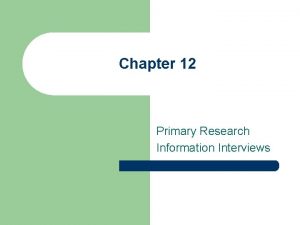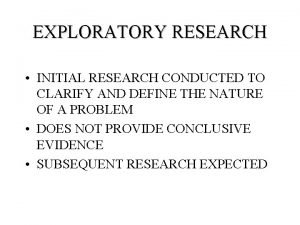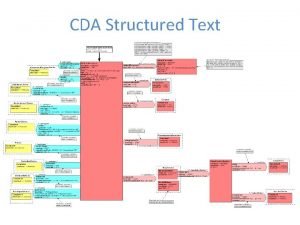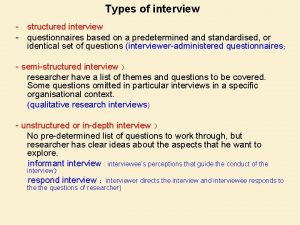Journalism 614 Survey Research Survey Research Structured interview



















- Slides: 19

Journalism 614: Survey Research

Survey Research ¨ Structured interview of: – Sample of individuals in order to generalize to a larger population ¨ Survey modes: – Face-to-face – Paper-and-pencil – RDD telephone – Direct mail – Internet

Advantages & Disadvantages 9 Generalizability - external validity 9 Representativeness - unbiased sample 9 Customizability - wide variety of research questions 4 4 Time - 6 months from start to finish Cost - Face-to-face vs. Telephone vs. Mail Hard to find facilities and experts Causality - Non-experimental design

Time and Survey Design ¨ Static designs: – Cross-sectional Survey - Poll ¨ Longitudinal designs: – Trend studies - Multiple Polls – Cohort studies – Study of Group Change – Panel studies – Study of Individual Change

Cross-sectional Study ¨ Static snapshot ¨ Slice of population at one point in time – E. g. , an opinion poll ¨ Inherent limitation: – Inability to capture change over time – Usually giving correlations not causal inferences

Cross Section Example

Trend Studies ¨ Measures changes over time ¨ Sequential cross-sections of the population – E. g. , Changes over time in: • Political knowledge levels • Concern about global warming • Presidential approval rating

Trend Example

Cohort Studies ¨ Tracking changes in a group as they age – Baby boomers (born during the post–World War II baby boom, approximately between 1946 and 1964) – Generation X – Millennials ¨ Measure change across the aging process – Do millenials become more conservative? – Why can’t you answer this question with a crosssectional design? – Untangle lifecycle vs. cohort differences

Cohort Example

Panel Studies ¨ Goes a step further: – interviewing the same people more than once ¨ Captures change in individuals over time – E. g. , NES Election Study • Pre-election and post-election ¨ Can begin to explain which individuals are changing and why they are changing ¨ The respondent mortality problem: – Are those who drop out different?

Panel Example

Misconceptions ¨ ¨ ¨ Single time-point >>> Longitudinal, Panel Designs Must be face-to-face >>> Can use telephone, mail Interviewers read questions >>> Self-administered Individuals as unit of observation >>> Family Non-experimental >>> Can embed experiments Atheoretical >>> Can test hypotheses Surveys are a very flexible research technique

Reliability of Survey Research ¨ Stability: – In panel designs, test-retest correlations ¨ Reproducibility: – In open-ended questions, coder agreement ¨ Internal Consistency: – In scales, the consistency of item response

Validity of Survey Research ¨ Face Validity: – Do items capture concepts? ¨ Content Validity: – Are relevant dimensions represented by indicators? ¨ Convergent Validity: – Are multiple indicators correlated? ¨ Divergent Validity: – Do indicators allow us to differentiate from other concepts? – Do indicators differentiate between distinct concept dimensions?

Stages in Survey Research ¨ General Research Questions ¨ Specific Research Questions ¨ Sampling Design ¨ Questionnaire Development ¨ Interviewer Training ¨ Pretest ¨ Fieldwork - Test ¨ Content Coding ¨ Analysis Computation ¨ Report Writing

Questionnaire Construction ¨ Length: – : 30 for telephone, longer for personal/self-administered ¨ Ordering: – Put an easy question first, funnel toward specific – Save sensitive question for the end ¨ Transitions: – Ease them from one section to another ¨ Probes: – Further information, elaboration

Training Interviewers ¨ Two parts: – 1. Basic interviewing skills – 2. Specific interview schedule, questionnaire

Motivations and Barriers ¨ Intrinsic and Extrinsic motivations: – expression, boredom, loneliness, politeness, curiosity, loyalty ¨ Barriers: – Suspicion, fear, inadequacy, privacy, distractions, time to answer ¨ Overcoming Barriers: – confidentiality, listening, probing, repeating, focus, and practice
 Cs 614
Cs 614 914-614-3221
914-614-3221 Literary journalism vs traditional journalism
Literary journalism vs traditional journalism Literary journalism vs traditional journalism
Literary journalism vs traditional journalism Unstructured interview
Unstructured interview Sa sd
Sa sd Semi structured interview questions
Semi structured interview questions What is qualitative questions
What is qualitative questions Moderately structured interview
Moderately structured interview Structured interview
Structured interview Unstructured interview
Unstructured interview Semi-structured clinical interview for financial capacity
Semi-structured clinical interview for financial capacity European health interview survey (ehis)
European health interview survey (ehis) Acls abcd
Acls abcd What is an interview schedule in research
What is an interview schedule in research Individual interview in research
Individual interview in research In depth interview in qualitative research
In depth interview in qualitative research Exploratory research
Exploratory research Focus group interview schedule
Focus group interview schedule Interview research method
Interview research method


































